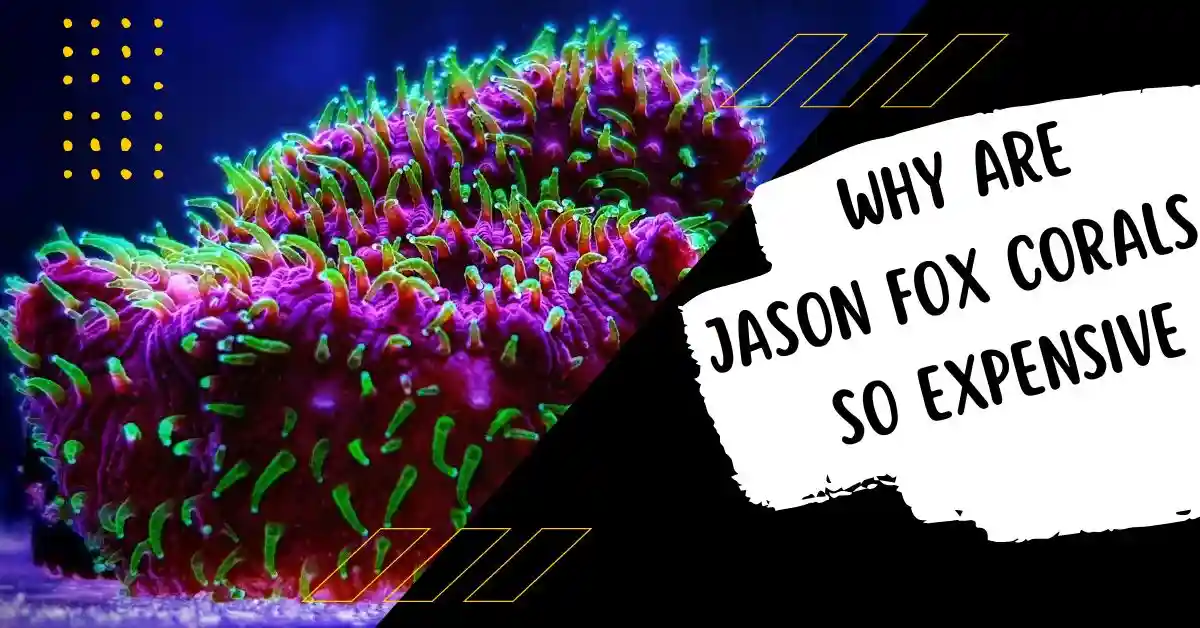Jason Fox is recognized for his extremely colorful, unusual corals. And they are introducing new coral species to the hobby.
But they come at a very high price which many of us can’t afford. So, you must be curious about Why are Jason Fox Corals so Expensive?
Jason Fox Corals come through a unique process, requiring both time and money. Because of that, the pricing becomes a little too much. Besides,
Jason Fox himself acquired them. The brand has its name, and they supply the healthiest corals. So, that’s why the corals are so expensive.
In this article, we will explain in detail and try to justify the price of these Jason Fox corals!
Jason Fox Corals
Jason Fox corals are unique in their ways. Cyphastreas that branch, bright montiporas with distinctive textures, and the still Jack-O-Lantern leptoseris are a specialty of theirs.
And, of course, many multi-colored Acroporas are among Jason Fox’s corals.
These discoveries, fortunately for reefers, thrive in captivity. However, for Jason, this prosperity means that they are quickly spreading throughout the hobby.
They even drive up demand for more new coral species from their consumers.
Is Jason Fox Corals Price Justified?
Jason Fox corals are very beautiful and unique. There are more than hundreds of different bloodline corals that are sold in the aquaculture industry. And the Jason Fox Surfer Montipora is only one example.
Moreover, you need to take care of the aquarium you will keep your corals in. You need to balance the calcium-magnesium level of the aquarium too.
But they are not for everyone. Because not everyone would pay such an amount to buy corals, and it requires the perfect eye to know the worth of the corals.
Reasons Behind Jason Fox Corals High Price
Though Jason Fox corals are expensive, He is one of the bestsellers in the market. For various reasons, Jason Fox is one of the best-selling sellers.
Jason Fox dives in the ocean for the corals a few times a year. He gets them personally. Therefore, they are not fabricated and have their beauty.
He holds off on releasing the frags for at least 6-7 months. It ensures that they color up and thrive in captivity.
Lineage corals have grown highly famous in recent years. And the majority of them are extremely vivid and difficult to find.
His frags are among the healthiest, most colorful, and pest-free pieces. However, they can show some problems. For example, corals may turn white.
Yet he hardly ever cuts them fresh. It’s important to value those corals, and to pay a nice amount is not much.
Several different activities could drive up the price of lineage coral. Some vendors, for example, restrict the number of corals supplied at a given period.
This could give the impression that it is scarce in the nature it’s harvested.
This makes these corals extremely pricey in the hobby. Also, the importance of creative marketing should not be overlooked. Some argue this pushes prices even higher since sellers give their corals catchy names.
The economic system of coral life also impacts the pricing of the Jason Fox corals.
Coral’s Economy and Cost
It’s important to know about the economy of the life system of corals. It will help you understand the high-end price of the corals.
A 12 to 1-inch frag of this coral can cost anything from $200 to $600. This inquiry has a simple answer.
Bloodline corals come from a seller’s collection and are exceptionally gorgeous.
Furthermore, due to their modest growth rate, corals like the Beach Bum typically attract a higher price that holds over time.
When demand is high to relatively high, it is difficult for a seller to justify offering a fragment for a lower price. These factors also explain why lineage corals are rarely found in local fish stores.
It’s tough to find parent colonies of bloodline corals like a local fish company in Ct.
It’s tough to justify paying $1200-$3000 as a business due to the high price tag. But scarcity and danger vs. value proposition (possibility of the coral dying).
Spending this much on a small colony and then looking to offload frags back to the shop. And subsequently, for customers, it is even more difficult for a special edition personal collection.
Because the upscale coral market is only a small proportion of a much bigger but niche market.
Rainbow chalice corals are an example of this. The Philippines produced the majority, though not all, but the multicolored chalices.
Although this coral is not extremely rare in the wild, it is illegal to gather coral from the Philippines.
How to Take Care of Jason Fox Corals in the Aquarium?
It’s easy to take care of the Jason Fox Corals at home. You need a nice big aquarium for them. And it needs low or moderate water pressure in the aquarium.
The corals need minimum lighting, so you have to maintain enough lighting of at least 150 par.
The water should have all the proper nutrients to maintain water chemistry. Corals can eat amphipods like many other things.
Here we recommend the best coral food for your corals. Thus you can take care of the corals.
So, it requires time, money, creativity, labor, and many other things to get those beautiful corals.
His rates on his website are out of the current. The best time to buy from him is during Live Sales or holiday discounts.
FAQs
What do the Jason Fox corals generally eat?
Fox Corals benefit from extra feeding times of Oysters, Roti, and Mysis shrimp, even though symbiont microalgae called zooxanthellae harbored within them provide some of their nutrient needs through photosynthesis.
It’s easy to take care of their feeding. But sometimes it can be a little expensive.
Is it True that Jason Fox corals are Aggressive?
Jason Fox Corals are calm and easy to keep. And it would be best if you kept them with other corals which are not aggressive.
This coral may grow up to 6 inches in length. And comes in a range of hues, including greenish, cream, whitish, pinkish, tan, and brown.
They live in your aquarium peacefully and balance the water life system of the aquarium.
How Does the Reproductive System of the Jason Fox Corals Work?
The Fox Coral may reproduce both sexually and asexually and is both male and female. Corals discharge eggs and sperm at about the same time to reproduce sexually.
This results in a fertilized ovum that swims around. It settles down and creates a little embryo, gradually becoming a coral.
Conclusion
This article should have answered the topic of why are Jason Fox corals so expensive while others are more fairly priced for newcomers to the hobby.
Regardless of one’s viewpoint, the market economy will evaluate the price of commodities.
So, the price of the Jason Fox corals is justified. And a true coral collector can understand their worth of them.

